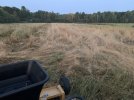They definitely seem to travel along the river corridor. It seems like flooding/wet springs has kept mature growth from developing near the west bank of the river and all the young growth seems like great bedding to me. lots of younger maple/aspen/and some birch on the west side. East side has all of the mature oaks but the woods are a little thin, interested to see what they look like with leaves down.
I've always been a very casual whitetail hunter. Was a bonafide waterfowl addict for about a decade when I spent 6 years on a 4 year degree in ND and the last 7 years i've been obsessed with western hunting. 2020 ended up with a wedding and a pregnancy so no more spending 3+ weeks hunting out west every year. Hoping this can fill that gap.
More than anything where I struggle is figuring out how to manage pressure, access routes, and stand locations. It seems like almost every stand location has flies in the ointment. Maybe that's just reality that the people selling habitat plans don't acknowledge?
I am 40 miles west of you.
If you are/were a western hunter, you are probably used to walking and covering ground. You can’t do that with 40 acres.
I would select two stands. One for N or NW
winds and one for East/ south winds. I would then stay out until the rut and only walk specific trails to those stands.
Don’t jump in with the chain saw and cut a lot of things this winter. Instead, walk the property thoroughly after your hunt is done. Maybe after the rifle and muzzle seasons are closed. Mark all rubs , scrapes, trails and beds on an aerial photo.
I did that for several years, all on paper when I bought my place. That was over 30 years ago. You can do it electronically if you wish.
You will need a sanctuary and it or they should be as much of the property as possible.
If you decide on a consultant, make sure he is familiar with your type of habitat.
They key is pinch points or funnels or whatever you want to call them. Every property has one or two. Once you find them, and figure out access with the proper wind, perhaps you can strengthen them. Perhaps they won’t need to be altered.
Enjoy the process and the time on the land. The journey can be more worthwhile than the big buck. It took me 15 years to figure that out.
Sent from my iPhone using Tapatalk
 I noticed a bunch of deer beds right behind it last time through there which was kind of a bummer.
I noticed a bunch of deer beds right behind it last time through there which was kind of a bummer.

